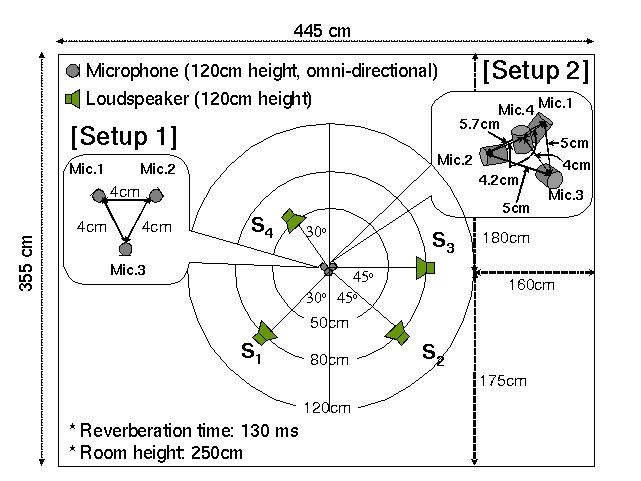
Fig. 1: Room for 4x3 tests.
This is the demonstration site for the IWAENC2005.
Details would be shown if my IWAENC2005 paper will be accepted ^^.
In the paper, we investigated four combinations of speakers and
averaged the separation results.
However, in this site, we show the sound demos of one of the combinations
for each setup.

To evaluate our method, we first tried to apply our method to the case of
N=4 and M=3.
Here the microphones were arranged in non-linear way (See Fig. 1, [Setup 1]).
We measured impulse responses under the conditions shown in Fig.1.
The reverberation time of the room was 130ms.
Mixtures at the microphones were made by convolving the
impulse responses and 5-second English speeches and adding them.
The sampling rate was 8 kHz.
In the table, the values show the separation performance SIR (Signal to Interference Ratio) improvement (Output SIR - Input SIR) and SDR (Signal to Distortion Ratio) in dB. (SIR, SDR)
Moreover, we also change the frame(window) shift size from L/2 to L/8, where
L is the window length.
From the results, we can see that our proposed method achieved
good separation performance
even if we utilized the non-linear sensor arrangement.
On the other hand,
in such a non-linear case, the conventional DOA-based method
cannot be applied straightforwardly.
The results also show that by using the fine-shift (L/4 and L/8), the SDR values increase without any reduction in the SIR values.
We can say that the fine-shift effectively reduce the signal distortion and musical noise when we employ it for our new observation vector clustering method.
| output1 | output2 | output3 | output4 | |
| Input SIR | -8.9 | -6.2 | -6.7 | +0.2 |
| shift L/2 | (16.3, 3.4)y1 | (10.7, 3.7)y2 | (14.4, 4.5)y3 | (9.7, 6.4)y4 |
| shift L/4 | (17.7, 4.5)y1 | (11.5, 4.3)y2 | (15.5, 5.1)y3 | (10.4, 6.9)y4 |
| shift L/8 | (18.1, 4.7)y1 | (11.7, 4.4)y2 | (16.1, 5.3)y3 | (10.4, 6.9)y4 |
This is the first result for a 3-dimentional sensor arrangement (Fig.1, [Setup 2]).
Here is the case of 4 sources and 4 sensors.
| output1 | output2 | output3 | output4 | |
| Input SIR | -8.1 | -5.3 | -6.6 | -0.6 |
| shift L/2 | (17.8, 4.2)y1 | (15.6, 6.1)y2 | (9.6, 3.6)y3 | (15.7, 11.5)y4 |
| shift L/4 | (19.0, 4.2)y1 | (16.5, 6.1)y2 | (9.9, 4.1)y3 | (17.0, 12.1)y4 |
| shift L/8 | (19.3, 4.9)y1 | (17.3, 6.6)y2 | (10.1, 4.2)y3 | (17.4, 12.2)y4 |